Munich , Bavaria’s capital, is home to centuries-old buildings and numerous museums. The city is known for its annual Oktoberfest celebration and its beer halls, including the famed Hofbräuhaus, founded in 1589. In the Altstadt (Old Town), central Marienplatz square contains landmarks such as Neo-Gothic Neues Rathaus (town hall), with a popular glockenspiel show that chimes and reenacts stories from the 16th century.
Today, Munich is a global centre of art, science, technology, finance, publishing, culture, innovation, education, business, and tourism and enjoys a very high standard and quality of living, reaching first in Germany and third worldwide according to the 2018 Mercer survey, and being rated the world’s most liveable city by the Monocle’s Quality of Life Survey 2018. Munich is consistently ranked as one of the most expensive cities in Germany in terms of real estate prices and rental costs. According to the Globalization and World Rankings ResearchToday, Munich is a global centre of art, science, technology, finance, publishing, culture, innovation, education, business, and tourism and enjoys a very high standard and quality of living, reaching first in Germany and third worldwide according to the 2018 Mercer survey, and being rated the world’s most liveable city by the Monocle’s Quality of Life Survey 2018. Munich is consistently ranked as one of the most expensive cities in Germany in terms of real estate prices and rental costs. According to the Globalization and World Rankings Researc Institute, Munich is considered an alpha-world city, as of 2015. It is one of the most prosperous and fastest growing cities in Germany. The city is home to more than 530,000 people of foreign background, making up 37.7% of its population.
Munich’s economy is based on high tech, automobiles, the service sector and creative industries, as well as IT, biotechnology, engineering and electronics among many other sectors. It has one of the strongest economies of any German city and the lowest unemployment rate of all cities in Germany with more than 1 million inhabitants. Munich is also one of the most attractive business locations in Germany. The city houses many multinational companies, such as BMW, Siemens, MAN, Allianz and MunichRE. In addition, Munich is home to two research universities, a multitude of scientific institutions, and world-renowned technology and science museums like the Deutsches Museum and BMW Museum. Munich’s numerous architectural and cultural attractions, sports events, exhibitions and its annual Oktoberfest, the world’s largest Volksfest, attract considerable tourism.
1.Marienplatz and the Neues Rathaus
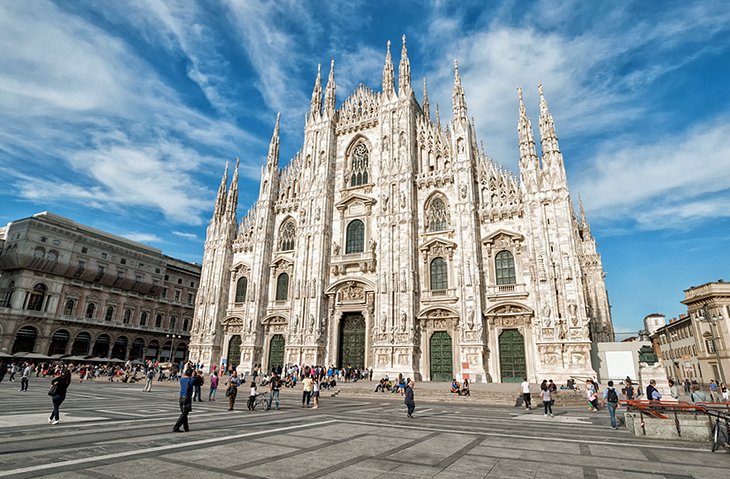
The New Town Hall is a town hall at the northern part of Marienplatz in Munich, Bavaria, Germany. It hosts the city government including the city council, offices of the mayors and a small portion of the administration. In 1874 the municipality had left the Old Town Hall for its new domicile.
Marienplatz has been Munich’s central square since the city’s foundation; the site of medieval jousting tournaments; and until 1807, where markets were held. In addition to the massive Neues Rathaus (New City Hall) that fills one entire side of the square, you’ll find the Altes Rathaus (Old Town Hall) forming a gate at the far end.
In the large open square are the Mariensäule, a tall column to the Virgin Mary erected in 1638, and the Fischbrunnen, a newer fountain that includes bronze figures rescued from an earlier 19th-century fountain. Popular with shoppers for its stores, boutiques, and restaurants, Marienplatz is the focus of festivals and scene of a large Christmas Market, one of several in the city. During the Fasching carnival, the Narren-Lindwurm (dragon) dances over the square.
The decision to construct a new building came due to the lack of space in the Old Town Hall and the adjoining, so-called “Lesser Town Hall” on Petersbergl (destroyed in 1944, not reconstructed). In memory of the bourgeois high season during the Gothic period, the choice fell upon a neo-Gothic design, which allowed an implement an independent architectural accent in contrast to the buildings of the royal family.
2.Nymphenburg Palace and Gardens
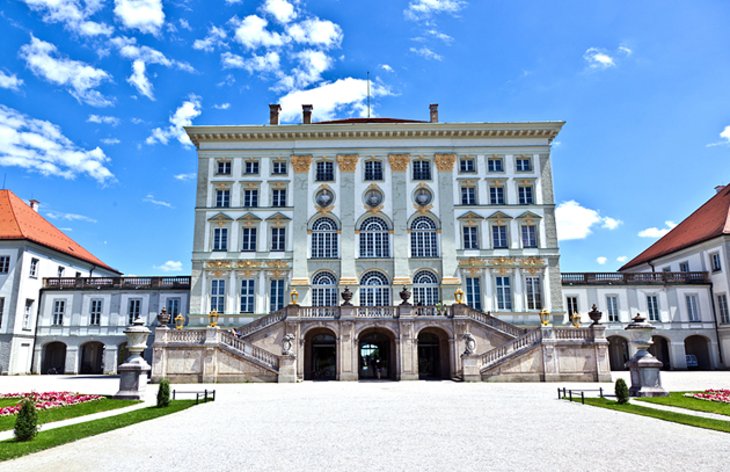
The large Baroque palace of Nymphenburg, in the northwest outskirts of the city, was originally the summer residence of the Wittelsbach Electors in the 17th century. Extending more than 600 meters from wing to wing, this vast palace is surrounded on each side by the Nymphenburg Canal, which splits as it passes around the main buildings before reuniting again in a fountain-adorned pool in front of the main façade.
Your first stop should be the Central Pavilion, a cube-shaped palace in the style of an Italian villa, completed in 1674 and home to the lavishly decorated three-story Stone Hall (Steinerner Saal) and a number of private chambers with fine furnishings and artwork. In the Palace Chapel, notice the expressive ceiling painting illustrating the life of Mary Magdalene. Beside the palace in the former Court Stables, the Marstallmuseum displays a collection of beautiful state coaches.
The exquisite composition of formal garden elements and English-style country park is considered a masterpiece of garden design and the spacious complex of palace and park has always been a popular attraction for local residents and tourists alike. To the east the park adjoins the palace buildings and the Grand circle. To the south and west the park is largely enclosed by the original Garden wall and borders the Botanical Garden to the north and beyond Menzinger Straße the park peripherie partly merges with the Kapuzinerhölzl forest.
The designs of the original Baroque gardens had largely been modeled on the French gardens at Vaux-le-Vicomte and Versailles. The modern park layout is the result of a fundamental redesign by Friedrich Ludwig Sckell, beginning in 1799. The park area within the Garden wall occupies 180 hectares and the complete complex covers 229 hectares.
3.Munich Residenz
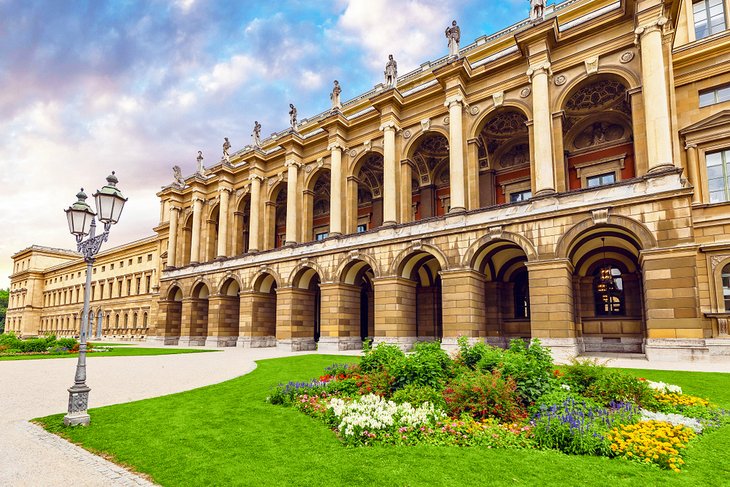
The Residenz in central Munich is the former royal palace of the Wittelsbach monarchs of Bavaria. The Residenz is the largest city palace in Germany and is today open to visitors for its architecture, room decorations, and displays from the former royal collections.
The complex of buildings contains ten courtyards and displays 130 rooms. The three main parts are the Königsbau (near the Max-Joseph-Platz), the Alte Residenz (Old Residenz; towards the Residenzstraße) and the Festsaalbau (towards the Hofgarten). A wing of the Festsaalbau contains the Cuvilliés Theatre since the reconstruction of the Residenz after World War II. It also houses the Herkulessaal (Hercules Hall), the primary concert venue for the Bavarian Radio Symphony Orchestra. The Byzantine Court Church of All Saints (Allerheiligen-Hofkirche) at the east side is facing the Marstall, the building for the former Court Riding School and the royal stables.
For centuries the seat of the dukes, electors, and kings of Bavaria, the Munich Residenz is one of Europe’s most spectacular palaces. Laid out around seven large courts, the vast Residenz complex comprises three main sections: the Königsbau, fronting onto Max-Joseph-Platz; the Alte Residenz, facing Residenzstrasse; and the Festsaalbau (Banqueting Hall), overlooking the Hofgarten.
The earliest section of this huge complex was the magnificent Antiquarium, built in 1579 and now part of the outstanding Residenz Museum. The Alte Residenz, a masterpiece of the late Renaissance and testimony to the growing power of Bavaria, followed soon after, and the final components – the Neoclassical Königsbau, the Festsaalbau, and the Court Church – were completed in 1848.
4.BMW Museum
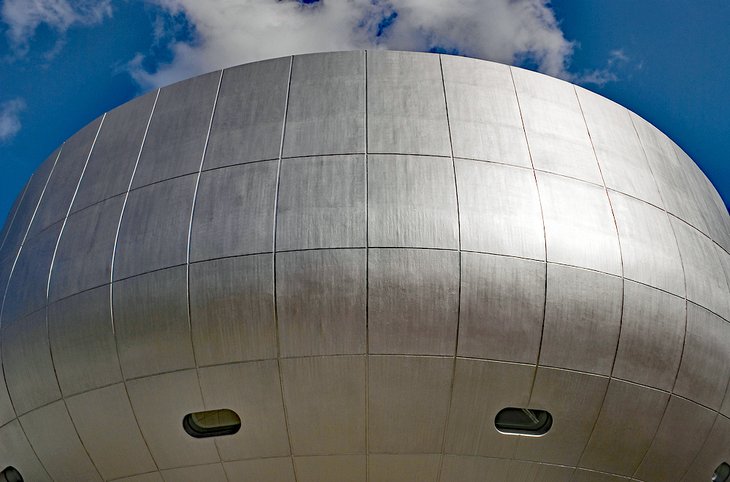
The BMW Museum is an automobile museum of BMW history located near the Olympiapark in Munich, Germany. The museum was established in 1973, shortly after the Summer Olympics opened. From 2004 to 2008, it was renovated in connection with the construction of the BMW Welt, directly opposite. The museum reopened on 21 June 2008. At the moment the exhibition space is 5,000 square metres for the presentation of about 120 exhibits.
Next to BMW’s soaring headquarters and factories at the Olympic Park is a round contemporary building with a metal shell, housing BMW’s museum. Here, car fans will find examples of nearly all the models the company has made, including sports cars, racing models, and motorcycles.
You can see current models and learn about the technology of modern automobile construction, as well as get glimpses of future propulsion technologies and designs the company is exploring. Those who think cars are just for getting from point A to point B might want to skip this one, but for fans of things automotive, it’s a must.
5.Viktualien markt
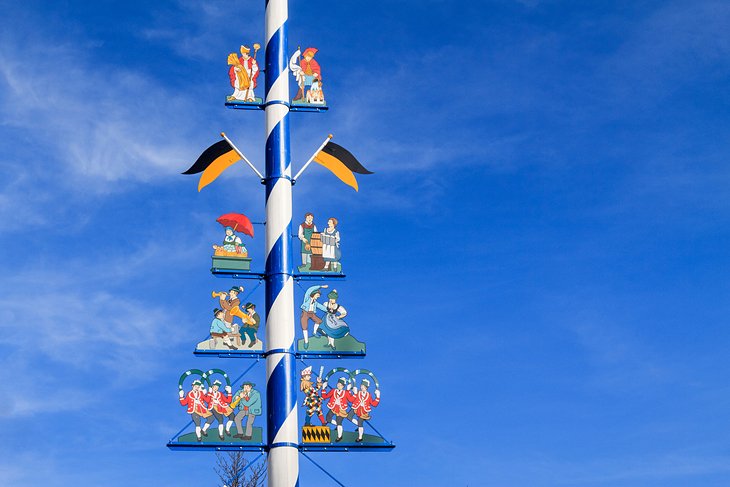
The Viktualienmarkt is a daily food market and a square in the center of Munich, Germany. It has been held daily since 1807, except on Sundays and public holidays. The Viktualienmarkt developed from an original farmers’ market to a popular market for gourmets.
De Viktualienmarkt is een permanente markt voor levensmiddelen in het centrum van de Duitse stad München. Sinds 1807 vindt hij dagelijks – met uitzondering van zon- en feestdagen – plaats.
Het meer dan twee hectare grote plein omvat meerdere vaste standplaatsen met soms uitgebreide uitstallingen. Daarbij komen de seizoensgebonden losse kramen. Dit alles geschikt in meerdere afdelingen rond een centrale biergarten. Op het plein vindt men ook de meiboom van München en meerdere fonteinen. Aan de noordzijde bevinden zich de Heilige Geestkerk en de “Alte Peter”.
In 1807, when the farmers market outgrew Marienplatz, it was moved to the nearby square, where it thrived and expanded, until today it covers 22,000 square meters and includes a butchers’ hall, bakery, fish hall, and flower market in addition to its fruit and vegetable vendors.
It’s not just a place for locals to buy items for the night’s dinner. Fresh breads and pastries, wheels of cheese, and cured meats are good picnic makings, and tables and benches provide a place for shoppers and visitors to sit while they eat sizzling sausages, hot pretzels, and other foods prepared in mobile kitchens.
6.Tierpark Hellabrunn (Hellabrunn Zoo)
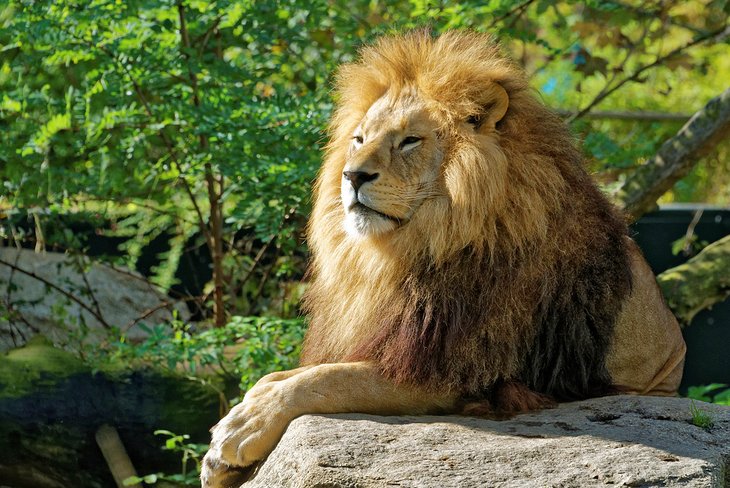
Hellabrunn Zoo (German: Tierpark Hellabrunn) is a 40 hectare (99 acre) zoological garden in the Bavarian capital of Munich. The zoo is situated on the right bank of the river Isar, in the southern part of Munich near the quarter of Thalkirchen.
A high ratio of enclosures are cageless, relying upon moat features to keep the animals in place. The zoo was the first zoo in the world not organized by species, but also by geographical aspects. For example, the wood bison share their enclosure with prairie dogs.
In 2013, the zoo was ranked the fourth best zoo in Europe (up from 12th). It focuses on conservation and captive breeding rare species such as the rare drill and silvery gibbons. Also gorillas, giraffes, elephants, wood bisons, elk and Arctic foxes were successfully bred in the zoo, which houses many species. It is one of the very few zoos that allows visitors to bring dogs.
Tierpark Hellabrunn is a member of the European Association of Zoos and Aquaria (EAZA) and the World Association of Zoos and Aquariums (WAZA) and participates in the European Endangered Species Programme (EEP).
Spread across 89 acres, Hellabrunn Zoo is consistently ranked among the best zoos in Europe. Laid out in 1911, it was the first zoo in the world to have animals grouped according to where they came from.
Today, more than 19,000 animals from 757 species are held in open enclosures meant to replicate the conditions of the wild, with animals that normally share habitats kept together wherever possible.
Popular features include the Elephant House (now a listed building), the enormous 5,000-square-meter free-flight aviary, the Polarium, and ape houses. Located adjacent to the Isar River in a designated conservation area, the zoo has many delightful footpaths, playgrounds, and picnic spots.
7.Peterskirche (St. Peter’s Church)
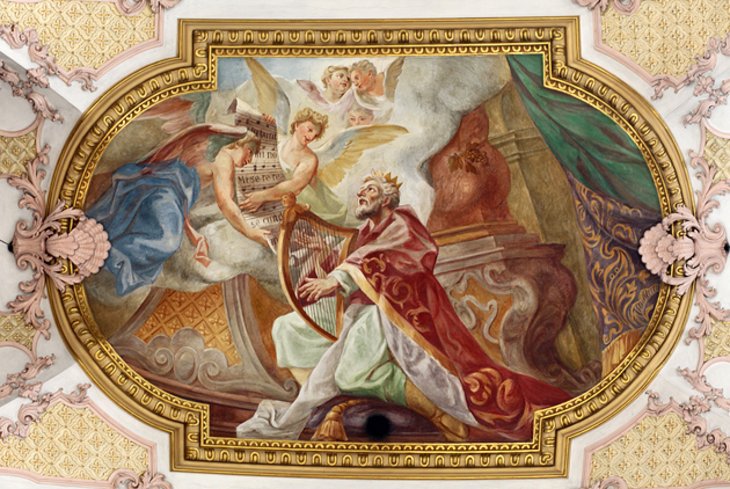
St. Peter’s Church is a Roman Catholic parish church in the inner city of Munich, southern Germany. Its 91-metre (299 ft) tower is commonly known as “Alter Peter”—Old Peter—and is emblematic of Munich. St Peter’s is the oldest recorded parish church in Munich and presumably the originating point for the whole city.
Known affectionately as Old Peter, St. Peter’s Church (Peterskirche) is Munich’s oldest parish church and stands on Petersberg, a small hill originally settled by monks. Built in Gothic style in 1386, the church was altered with the addition of a Baroque choir with three apses in 1636, while the tower was given a lantern dome in place of its earlier Gothic spires.
Interior highlights include the font by Hans Krumper, the red marble monuments by Erasmus Grasser, and the 15th-century Schrenk Altar with its sculptures of the Crucifixion and the Last Judgment. Also of note is the 20-meter-tall 18th-century high altar with its figures of the Four Fathers of the Church and St. Peter.









